Exercises (2269)
Jump in place one-legged (right)
Power
Individual work


One-legged stand (right), arms supported on the hips or bent in front of the body. Powerful jump vertically into the air.
Attention:
Keep your upper body upright (keep your core tensed).
Lighten:
Smaller/less intense jumps.
Harden:
Bigger/more intense jumps; additional weight (on your chest/shoulders, hold in your hands, in front of you).
Variation:
With each jump, pull the tips of your feet towards your knees (bend your feet).
1 weight cuff/weight vest/weight disc/(medicine) ball/sandbag/fighting backpack/2 dumbbells ► Make the exercise more difficult (additional weight)
Jump on the spot one-legged (right) (one-legged jump) ► pogo tuck jump
Power
Individual work
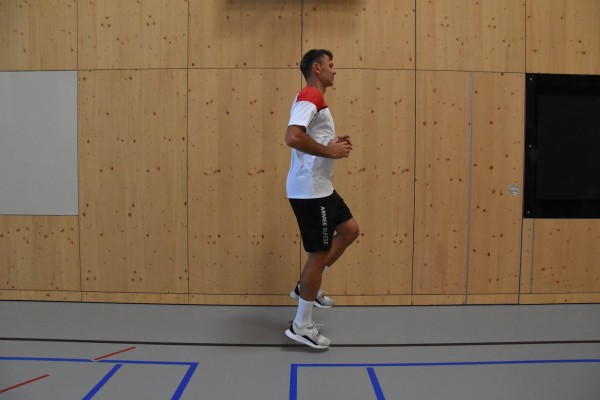
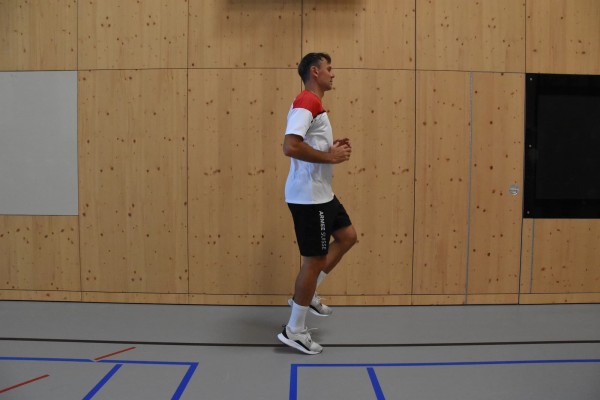
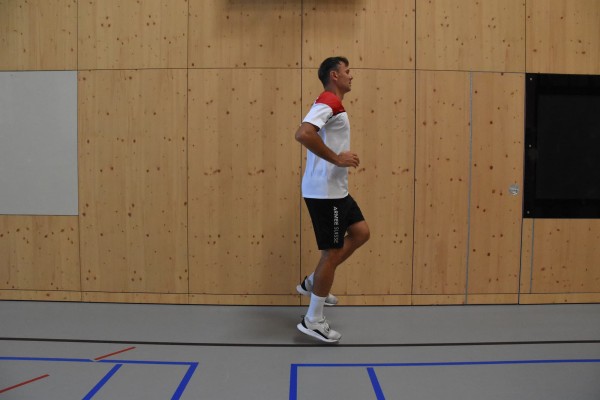
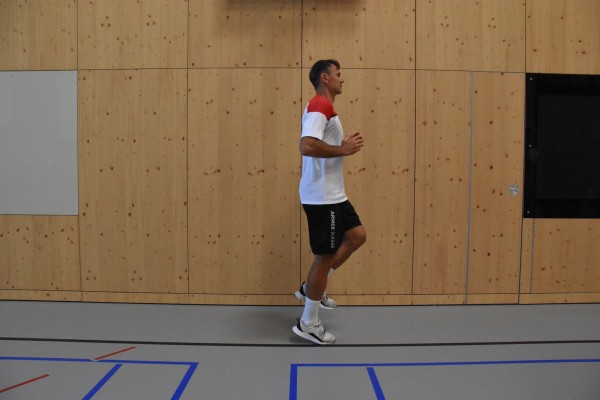
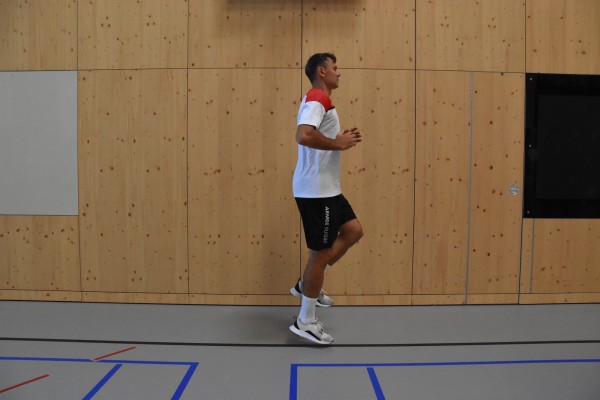
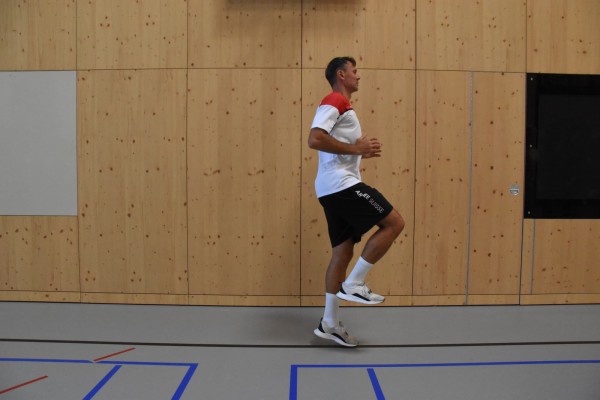
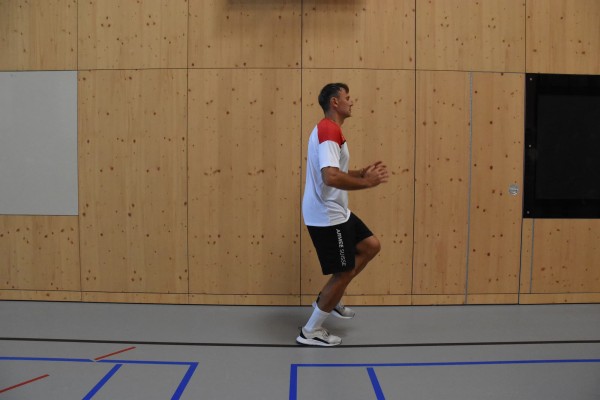
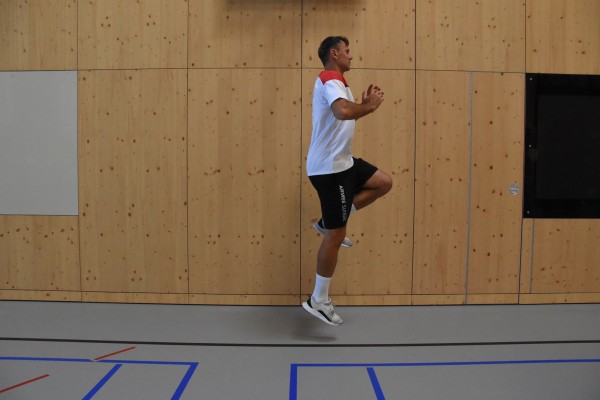
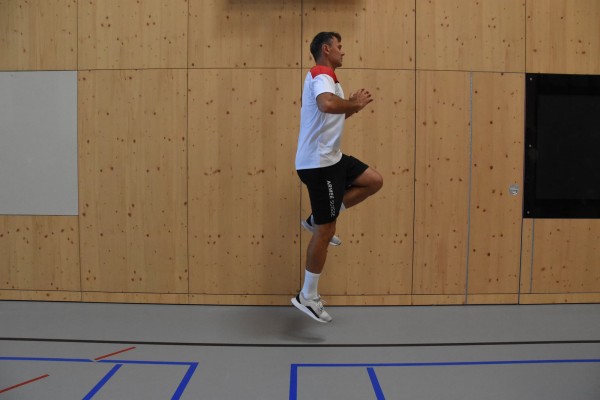
Steady hopping in place on one leg (right) without putting your heel down completely. Every few repetitions (e.g. always after 5 small hops) perform a jump upwards (one-legged jump). The arms can support the jump by pulling them up and overhead when jumping from hip height.
Attention:
Keep your upper body upright (tense your core).
Lighten:
Smaller/less intense jumps into the air.
Harden:
Higher/intensive jumps; additional weight (on your chest/shoulders, hold in your hands, hold in front of you).
Variation:
Pull the tip of your foot towards your knee (bend your foot) with each jump.
1 weight cuff/weight vest/weight disc/(medicine) ball/sandbag/fighting backpack/2 dumbbells ► Make the exercise more difficult (additional weight)
Jump on the spot one-legged (right) (one-legged jump) ► rudiment hop
Power
Individual work
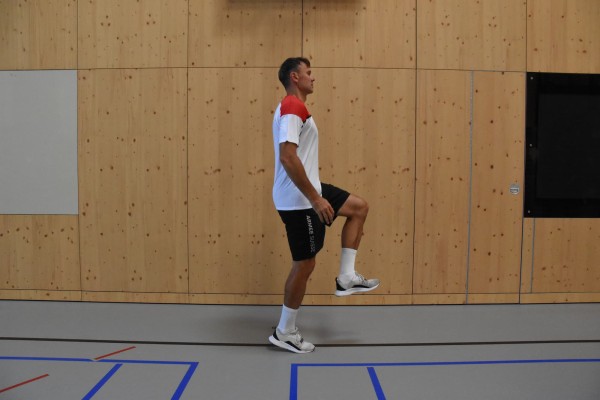
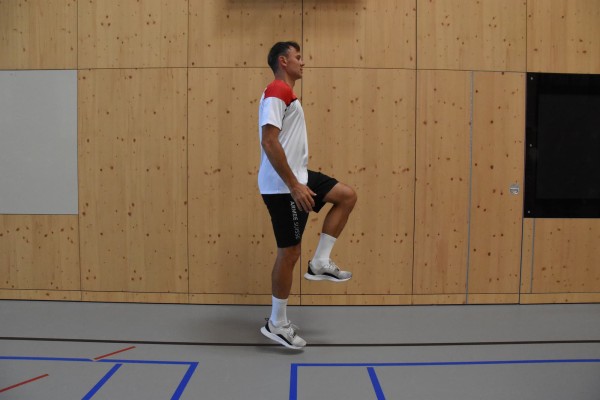
Stand on one leg (right), with the free (left) leg raised (approximately right angle in the knee joint so that the knee is at hip height in front of the body). Jump steadily in place, putting your heel down completely with each repetition.
Attention:
Keep your upper body upright (keep your core tensed).
Lighten:
Smaller/less intense jumps.
1 weight cuff/weight vest/weight disc/(medicine) ball/sandbag/fighting backpack/2 dumbbells ► Make the exercise more difficult (additional weight)
Jump in place with extension and flexion of one leg alternating ► runner hop
Power
Individual work
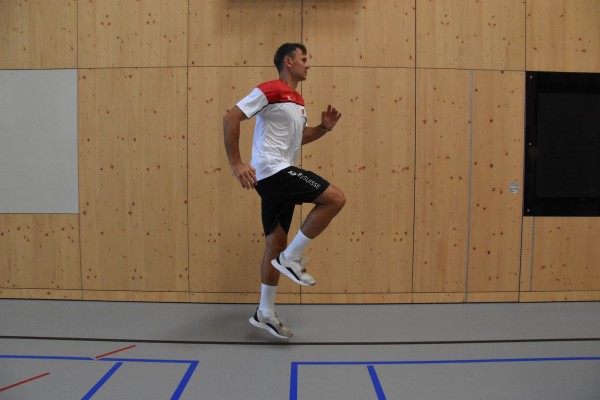
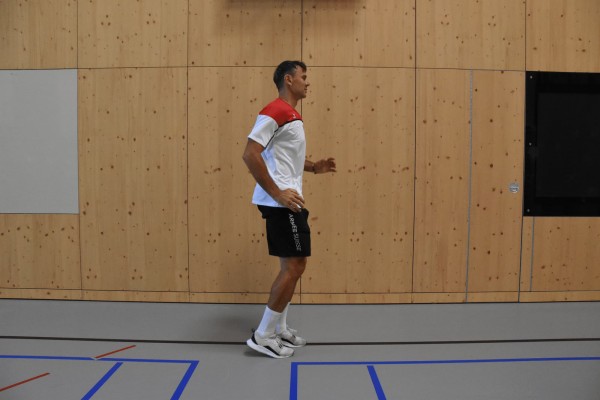
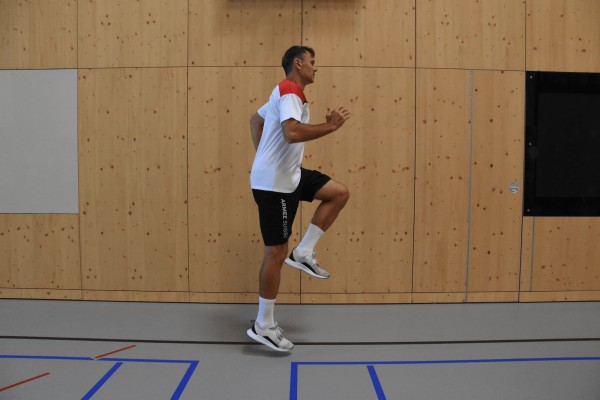
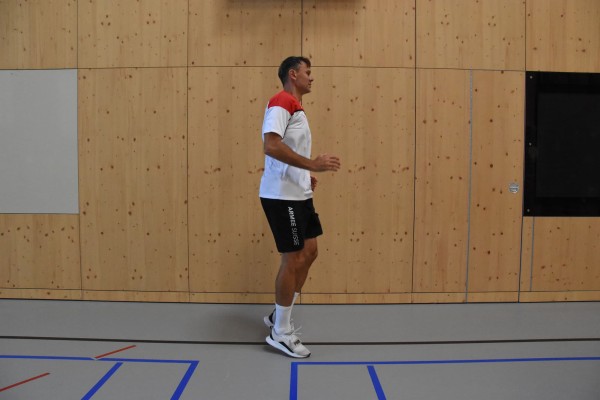
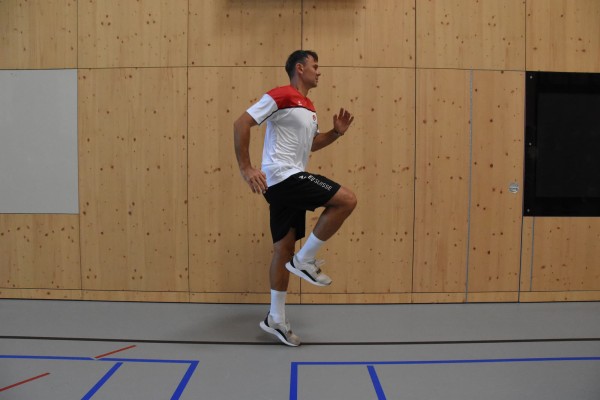
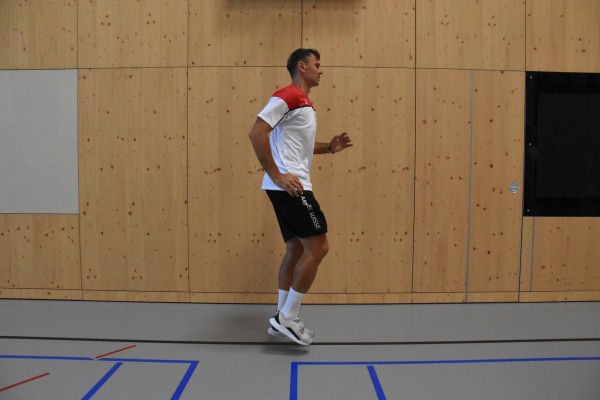
Stand upright with your feet shoulder-width apart, hopping steadily in place. Alternately bend one leg during the two-legged small jump (raise the knee in front of the body to approximately hip height). Land on both legs (heels completely off the ground), keeping the ground contact time as short as possible before the next repetition. Support your arms on your hips or support the movement with your arms (arms bent and stretched - arm bent on the opposite side where the knee is raised - sprinter position).
Caution:
Keep your upper body upright (tense your core).
Lighten:
Smaller/less intense jumps (lift your knees less).
Harden:
Higher/more intense jumps; additional weight (on your chest/shoulders, hold in your hands, in front of you).
2 weight cuffs/short dumbbells/1 weight vest/weight disc/(medicine) ball/sandbag/fighting rucksack ► Make the exercise more difficult (additional weight)
Jump in place and flexion and extension of the legs
Power
Individual work

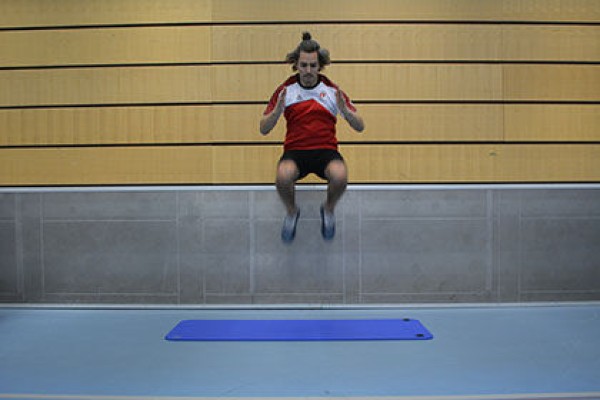


Stand upright on the balls of your feet with your knees slightly bent and your arms bent in front of your body (or supported on your hips). Jump up into the air and bend your legs (raise your knees approximately to navel height). Bounce steadily in place (fast frequency) without putting your heels down (jump on your toes).
Attention:
Keep your upper body upright (keep your core tensed).
Lighten:
Lift your knees less, smaller/less intense jumps.
Harden:
Lift your knees further; bigger/more intense jumps; additional weight (on your chest/shoulders, hold in your hands, hold in front of you).
2 weight cuffs/short dumbbells/1 weight vest/weight disc/(medicine) ball/sandbag/fighting backpack ► Make the exercise more difficult (additional weight)
Jump in place and hip rotation ► jump + hip rotation
Power
Individual work
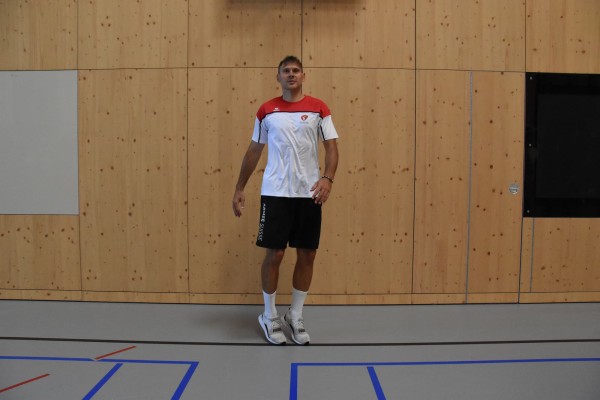
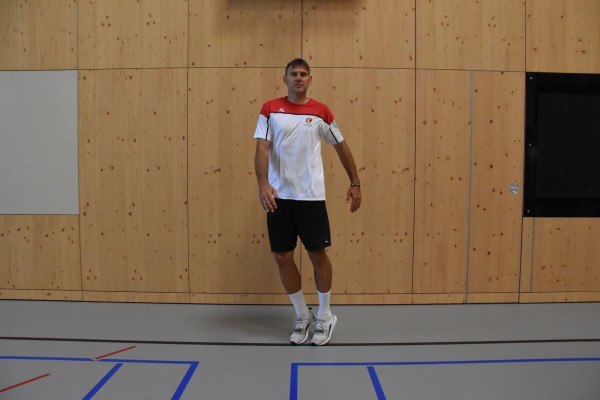
Continuous jumping with both legs in place (feet closer than shoulder width), with the hips alternately turned out to one side (feet pointing to the respective side). The upper body and gaze always remain directed forwards, the heels are never fully lowered.
Attention:
The upper body remains upright (tense the torso).
Harden:
Additional weight (on the chest/shoulders, hold in the hands, hold in front).
2 weight cuffs/short dumbbells/1 weight vest/weight disc/(medicine) ball/sandbag/fighting backpack ► Make the exercise more difficult (additional weight)
Jump onto an object
Power
Individual work


Jump onto the long bench on both legs and back down again.
Attention:
Keep your upper body upright, cushion your landing.
Lighten:
Jump over a line (omit the long bench); choose a lower element (e.g. vaulting box top); lower cadence.
Harden:
After standing on the long bench, jump upwards; choose a higher element; keep additional weight on your feet/shoulder; higher cadence.
1 long bench
1 vaulting box top section ► Make the exercise easier (position)
2 vaulting box elements (incl. top section) ► Make the exercise more difficult (position)
2 weight cuffs/1 weight vest/sandbag ► Make the exercise more difficult (additional weight)
Jump onto an object ► box jump
Power
Individual work




From a standing position, tilt your upper body slightly forwards, stretch your arms backwards at an angle to your body (like a ski jumper on a ski jump), push off the ground powerfully to jump onto a raised object (plyo box or swinging box element incl. top) (use the momentum of your arms), straighten your upper body (stand on the object) and jump back to the starting position (possibly the other side of the object).
Attention:
Land as softly as possible (cushion the jump with your knees).
Lighten:
Lower the intensity between each execution; lower the height of the object.
Harden:
Additional weight; higher object.
Variation:
Bouncing from one side of the object to the other by jumping sideways.
1 flat bench/plyo box/swivel box
2-4 weight cuffs/1 weight waistcoat ► Make the exercise more difficult (additional weight)
Jump from a kneeling position to a squat position (kneeling jumps) ► kneeling jump
Power
Individual work



Stand on your knees (possibly with your buttocks sitting on your feet), your arms hanging down at the side of your body and your upper body upright. The buttocks and leg muscles are tensed and the arms are brought back to gain momentum. Then, with an explosive movement, hop onto both feet simultaneously (landing in a squat position), bringing your arms up quickly and pushing your hips forwards.
Attention:
The exercise requires a certain amount of explosiveness in the legs and is therefore rather demanding.
Lighten:
Significantly greater support from the arms (momentum).
Harden:
Additional weight; soft surface.
2 weight cuffs/1 weight vest/fighting backpack ► making the exercise more difficult (additional weight)
1 small soft mat ► making the exercise more difficult (base)
Jump from kneeling to standing (kneeling jumps) and jump into the air ► kneeling jump / kneeing jump
Power
Individual work
Stand on your knees (possibly with your buttocks sitting on your feet), your arms hanging down at the side of your body and your upper body upright. The buttocks and leg muscles are tensed and the arms are brought back to gain momentum. Then, with an explosive movement, hop onto both feet simultaneously (landing in a squat position), bringing your arms up quickly and pushing your hips forwards. After landing, you immediately jump up with both legs (with as little contact time with the ground as possible).
Attention:
The exercise requires a certain amount of explosiveness in the legs and is therefore rather demanding.
Lighten:
Significantly greater support from the arms (momentum).
Harden:
Additional weight; soft surface.
2 weight cuffs/1 weight vest/fighting backpack ► making the exercise more difficult (additional weight)
1 small soft mat ► making the exercise more difficult (base)
Jump from kneeling to standing (kneeling jumps) and jump into the air including rotation (left) ► kneeling jump / kneeing jump
Power
Individual work
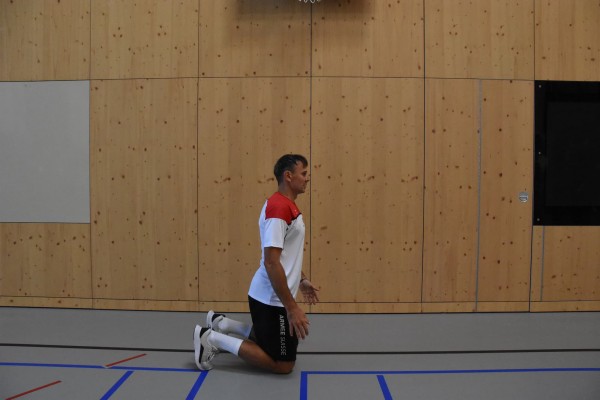
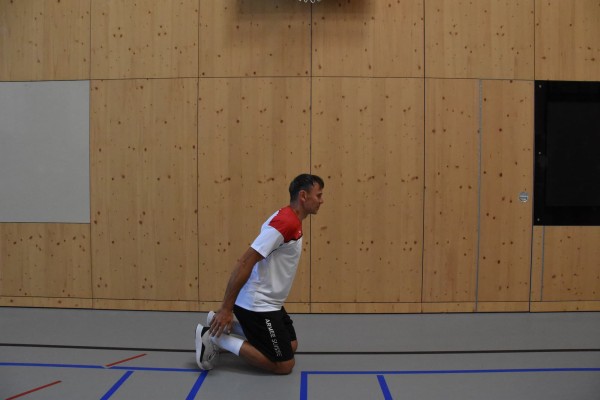
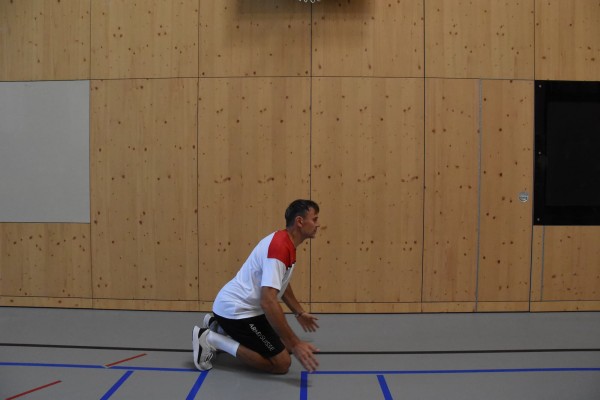
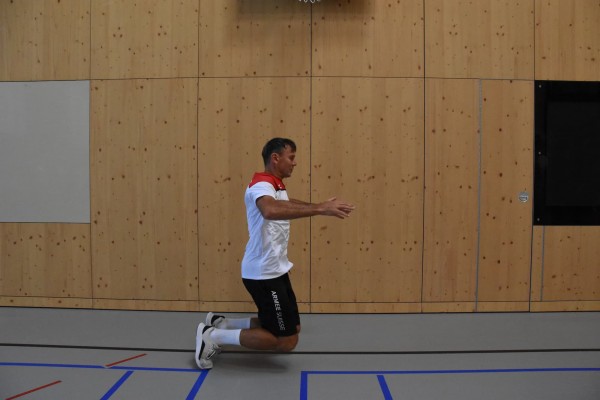
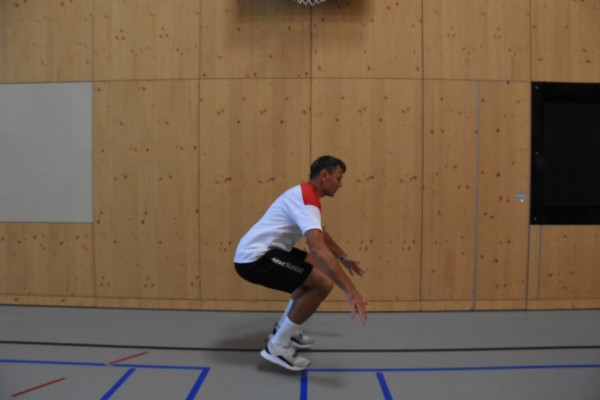
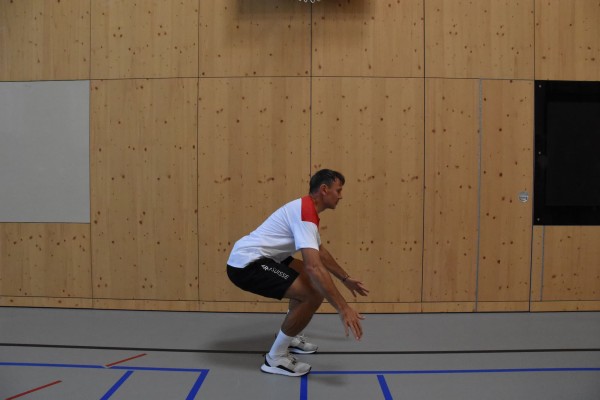
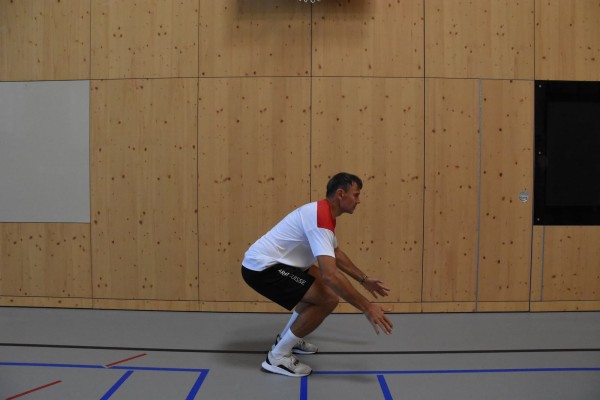
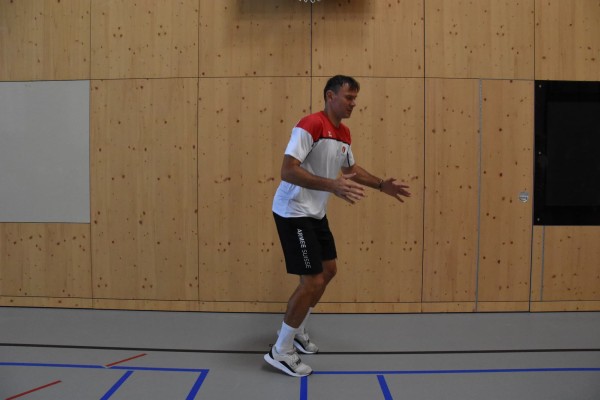
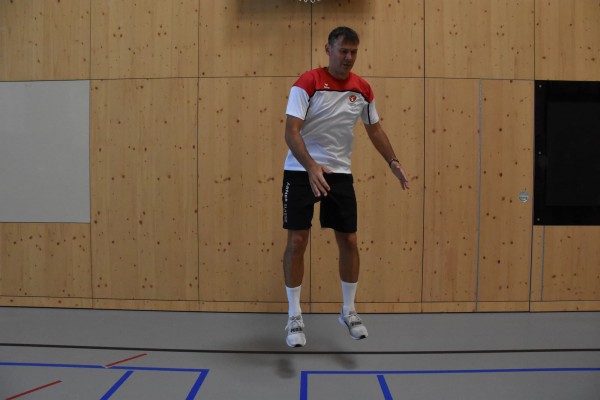
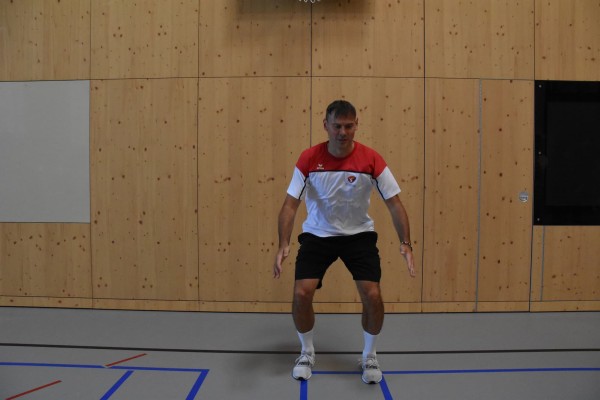
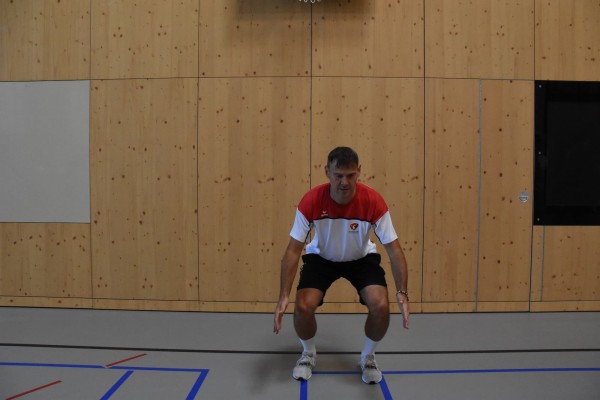
Stand on your knees (possibly with your buttocks sitting on your feet), your arms hanging down at the side of your body and your upper body upright. The buttocks and leg muscles are tensed and the arms are brought back to gain momentum. Then, with an explosive movement, hop onto both feet simultaneously (landing in a squat position), bringing your arms up quickly and pushing your hips forwards. After landing, you immediately jump up with both legs (keeping your contact time with the ground as short as possible), rotating your body 90 degrees to the left side in the air (landing facing the left side, in the starting position you are facing forwards).
Attention:
The exercise requires a certain amount of explosiveness in the legs and is therefore rather demanding.
Ligthen:
Significantly greater support from the arms (momentum).
Harden:
Additional weight; soft surface.
2 weight cuffs/1 weight vest/fighting backpack ► making the exercise more difficult (additional weight)
1 small soft mat ► making the exercise more difficult (base)
Jump from kneeling to standing (kneeling jumps) and jump into the air including rotation (right) ► kneeling jump / kneeing jump
Power
Individual work
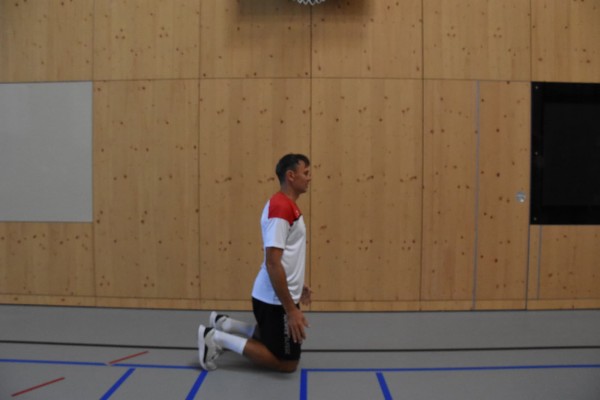
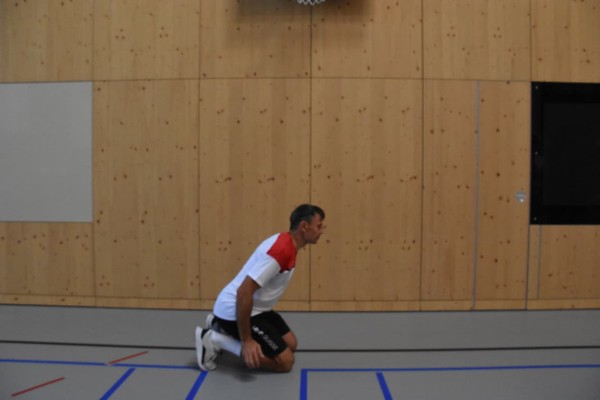
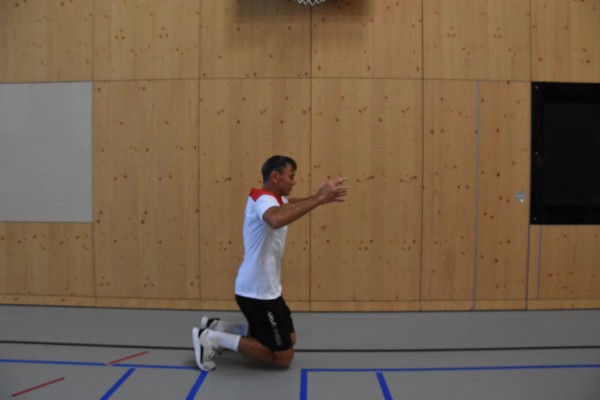
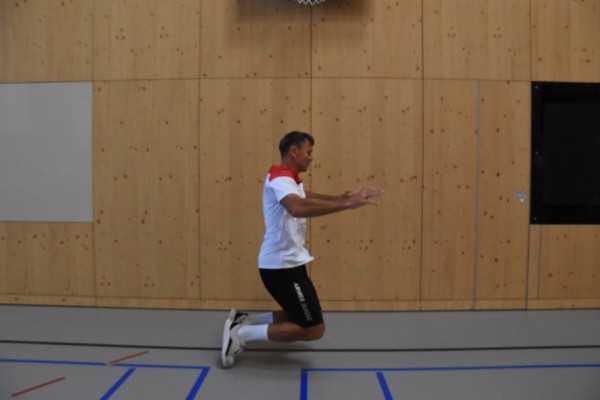

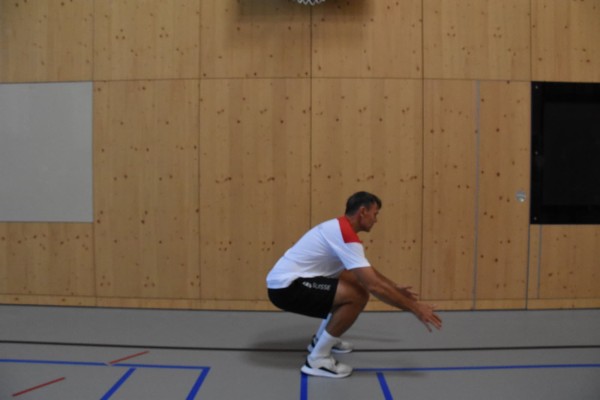
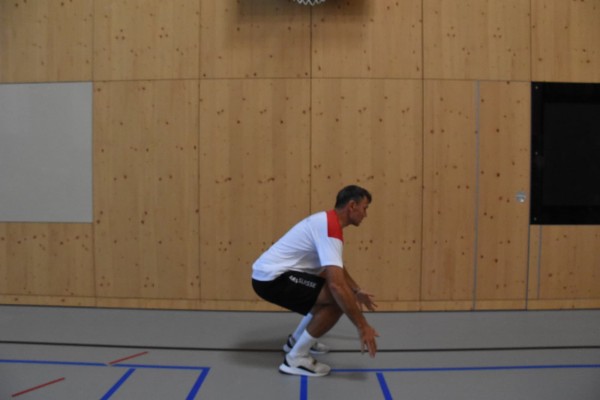
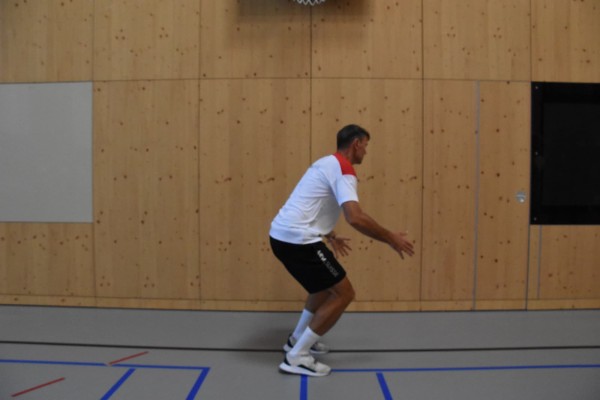
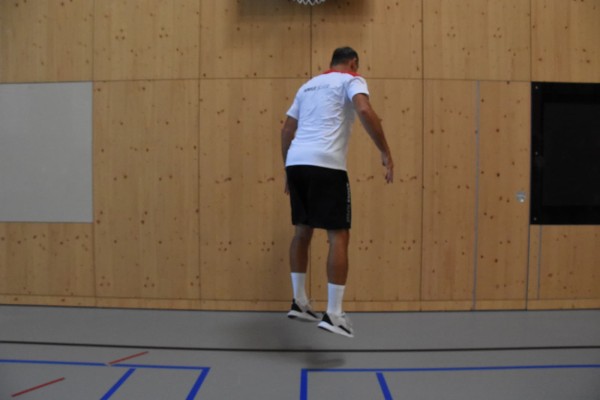
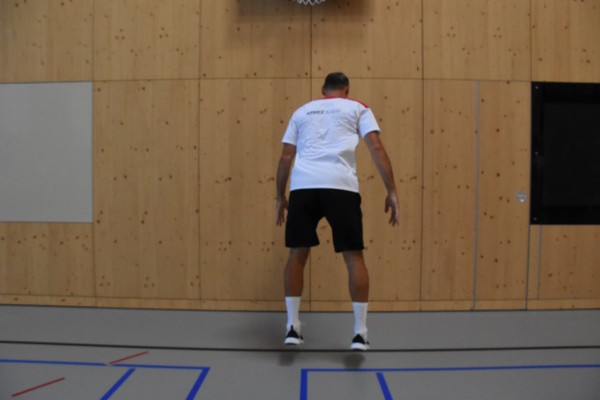
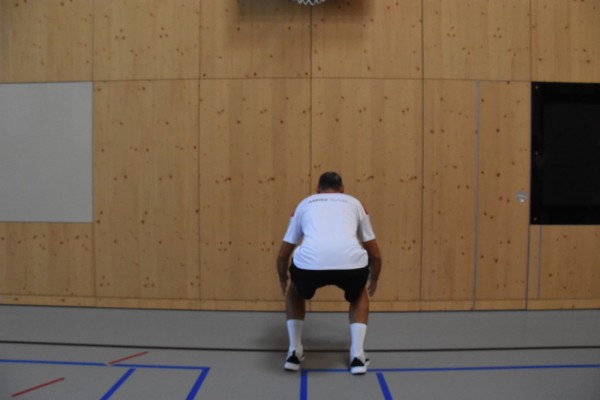
Stand on your knees (possibly with your buttocks sitting on your feet), your arms hanging down at the side of your body and your upper body upright. The buttocks and leg muscles are tensed and the arms are brought back to gain momentum. Then, with an explosive movement, hop onto both feet simultaneously (landing in a squat position), bringing your arms up quickly and pushing your hips forwards. After landing, you immediately jump up with both legs (keeping your contact time with the ground as short as possible), rotating your body 90 degrees to the right side in the air (landing facing the right side, in the starting position you are facing forwards).
Attention:
The exercise requires a certain amount of explosiveness in the legs and is therefore rather demanding.
Lighten:
Significantly greater support from the arms (momentum).
Harden:
Additional weight; soft surface.
2 weight cuffs/1 weight vest/fighting backpack ► making the exercise more difficult (additional weight)
1 small soft mat ► making the exercise more difficult (base)
Jump from kneeling to standing (kneeling jumps) and jump into the air including rotation ► kneeling jump / kneeing jump
Power
Individual work




















Stand on your knees (possibly with your buttocks sitting on your feet), your arms hanging down at the side of your body and your upper body upright. The buttocks and leg muscles are tensed and the arms are brought back to gain momentum. Then, with an explosive movement, hop onto both feet simultaneously (landing in a squat position), bringing your arms up quickly and pushing your hips forwards. After landing, immediately jump up with both legs (keeping contact with the floor as short as possible), rotating the body 90 degrees in the air. Switch sides after each repetition so that you land facing the left or right side (starting position facing forwards).
Attention:
The exercise requires a certain amount of explosiveness in the legs and is therefore rather demanding.
Lighten:
Significantly greater support from the arms (momentum).
Harden:
Additional weight; soft surface.
2 weight cuffs/1 weight vest/fighting backpack ► making the exercise more difficult (additional weight)
1 small soft mat ► making the exercise more difficult (base)
Jump in all directions
Power
Individual work




Both-legged jumps into and out of the object lying on the floor (e.g. tyre) or jump over an object (e.g. combat backpack), integrating both forward, backward and sideways jumps into the exercise.
Attention:
Danger of tripping.
Keep your knees stable and behind the tips of your feet.
Lighten:
Jump without an object or just jump from a standing position behind the object forwards and back to the starting position; jump over a smaller object (e.g. combat rucksack instead of a tyre).(e.g. combat rucksack instead of tyre or helmet instead of combat rucksack); lower cadence.
Harden:
Higher cadence; additional weight (on the feet).
1 tyre (10DM)/fighting rucksack
1 helmet ► Make the exercise easier
2 weight cuffs/1 weight vest/sandbag ► Make the exercise more difficult (additional weight)
Leap into the air
Power
Individual work


Stand upright with your feet shoulder-width apart and your arms supported on your hips. Jump straight up with both legs (feet extended during the flight phase).
Attention:
Maintain an upright position (body tension).
Ligthen:
Smaller/less intense jumps.
Harden:
Hold additional weight (on the legs, on the shoulders, in the hands); jump on a soft surface.
Variant I:
Never put your heels down completely.
Variant II:
Pause between jumps (complete stance) or jump continuously.
Variant III:
Touch the floor with your hands after each jump (knee bend), stretch your arms upwards during the jump (stretch jump).
Variant IV:
Pull your knees up to the height of your navel at the same time as you jump, arms bent in front of you.
2 weight cuffs/short dumbbells/1 weight vest/sandbag/fighting backpack ► making the exercise more difficult (additional weight)
1 small/large soft mat ► making the exercise more difficult (base)
Leap into the air
Power
Individual work


Round course over box elements of different heights. Place a soft mat (small) between the elements and at the end of the course (crosswise - wide side of the mat facing the long side of the box). Jump onto the vaulting box element with both legs and back down again.
Attention:
Pause briefly on the vaulting box, cushion the landing with your legs (lower your buttocks), do not let your knees swing outwards/inside.
Lighten:
Less high elements.
Harden:
Higher elements.
Variant:
When jumping down, jump up again immediately after landing (explosive power) or take a roughly right angle with your knees when landing and hold this position briefly before jumping off again.
3 Swedish box
3 soft mats (small)
Jump into the air (squat jump) ► tuck jump
Power
Individual work


Stand upright shoulder-width apart with your arms outstretched at chest height in front of you, bend your legs slightly (squat down slightly) and push your legs off the floor in a fluid movement to jump upwards (raise your arms horizontally as a swing). During the jump, pull your knees up towards your chest as far as possible (squat jump). Then land in a controlled manner (cushion the jump) and initiate the next jump.
Attention:
Keep your back straight, cushion the jump as you land, keep your whole foot on the ground without bending your knees and keep your knees behind your toes while your legs are in contact with the ground. The palms of your hands touch your knees with every jump.
Ligthen:
Smaller/less intense jumps, pull your knees up less.
Harden:
Additional weight; jump on a soft surface.
2-4 weight cuffs/2 dumbbells/1 weight waistcoat ► Making the exercise more difficult (additional weight)
1 small/large soft mat ► Making the exercise more difficult (base)
One-legged jump into the air (left)
Power
Individual work


Stand upright on one leg (right leg slightly raised off the ground or bent) with your arms supported on your hips. Take a powerful jump with the training leg (left) straight up into the air (stretch your foot during the flight phase).
Attention:
Maintain an upright position (body tension).
Lighten:
Smaller/less intense jumps.
Harden:
Hold additional weight (on the leg, on the shoulders, in the hands); jump on a soft surface.
Variant I:
Pause between jumps (complete stance) or continuous jumping.
Variant II:
Tighten the knees to the height of the navel at the same time as jumping.
1 weight cuff/weight vest/sandbag/fighting backpack/2 dumbbells ► making the exercise more difficult (additional weight)
1 small/large soft mat ► making the exercise more difficult (base)
One-legged jump into the air (right)
Power
Individual work


Stand upright on one leg (left leg slightly raised off the ground or bent) with your arms supported on your hips. Take a powerful jump with the training leg (right) straight up into the air (stretch your foot during the flight phase).
Attention:
Maintain an upright position (body tension).
Lighten:
Smaller/less intense jumps.
Harden:
Hold additional weight (on the leg, on the shoulders, in the hands); jump on a soft surface.
Variant I:
Pause between jumps (complete stance) or continuous jumping.
Variant II:
Tighten the knees to the height of the navel at the same time as jumping.
1 weight cuff/weight vest/sandbag/fighting backpack/2 dumbbells ► making the exercise more difficult (additional weight)
1 small/large soft mat ► making the exercise more difficult (base)
Jumping up and flexing the arms on a slope (pull-up) ► jumping pull up
Power
Individual work


Stand upright and position yourself slightly offset backwards under a high bar. With a small hop, bring your outstretched arms to the bar with an overhand grip (back of hand pointing towards your face). As soon as you have grasped the bar, bend your arms in one smooth movement to pull your upper body up as vertically as possible until your chin is over the bar (arms almost at shoulder height). Then release your hands from the bar to land on the floor in a standing position.
Attention:
Pull your body up as vertically as possible.
Lighten:
Stand with both feet or one foot in the loop of an elasticated rubber band attached to the horizontal bar.
Harden:
Additional weight.
Variant:
Grab the bar with an underhand grip (palm facing your face).
1 horizontal bar
1 elasticated rubber band ► Make the exercise easier (support)
2 weight cuffs/1 weight waistcoat ► Make the exercise more difficult (additional weight)
Leap into the distance
Power
Individual work
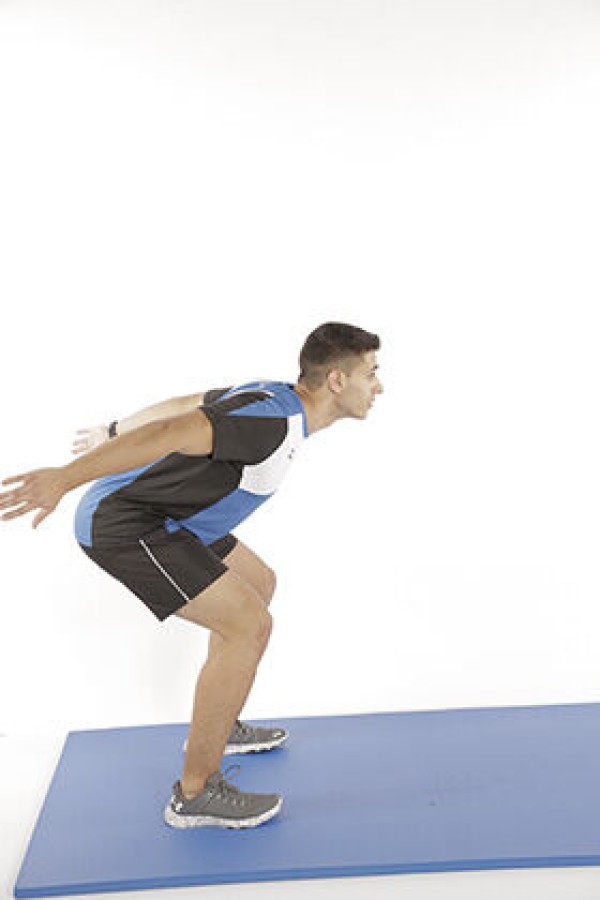

Stand with your hips wide apart, legs slightly bent and arms supported on your hips. Jump forwards with both legs, then hop backwards to the starting position.
Attention:
Lower your buttocks backwards when landing (do not move your knees forwards), pause briefly with your knees bent after each landing.
Lighten:
Bend your knees less (greater angle); less wide/intense jumps.
Harden:
Bend your knees more (smaller angle); hold your arms in front of you; hold additional weight (on your shoulders, in front of your chest or in your hands).
Variant:
Arms support the movement by swinging with you (lead from back to front when jumping forwards).
2-4 weight cuffs/2 weight balls/dumbbells/1 weight vest/weight disc/sandbag/fighting rucksack ► Make the exercise more difficult (additional weight)
Jump forwards and shift backwards in a four-footed stance alternating ► bear crawl jump
Power
Individual work



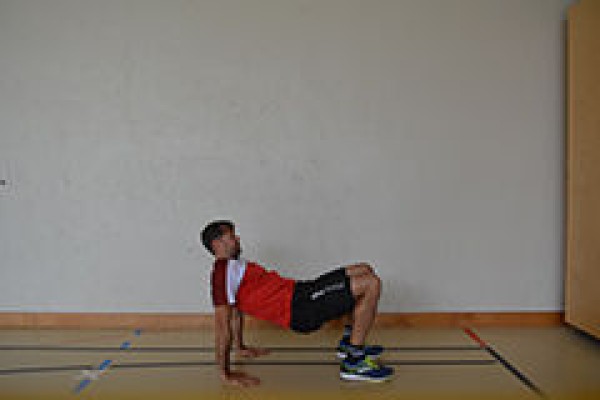


Stand with your hips wide apart, legs slightly bent and arms supported on your hips, jump forwards with both legs. Then, in an inverted four-footed stance (chest facing upwards, body supported on the hands and feet, fingertips pointing forwards), shift back to the starting point. When moving on all fours, the arms are almost fully extended, the legs are bent and the movement is in the direction of the arms.
Attention:
Always keep your knees behind the tips of your feet when jumping, pause briefly with your knees bent after each landing.
Lighten:
Bend your knees less (greater angle) when jumping and landing; jump less far forwards.
Harden:
Bend your knees more (smaller angle) when jumping and landing; jump with your arms in front of you; additional weight.
Variation:
Don't keep your arms supported or in front of you, but actively support the jump with your arms (with momentum).
2-4 weight cuffs/1 weight waistcoat ► Make the exercise more difficult (additional weight)
Jump to the slope I
Parkour
Individual work

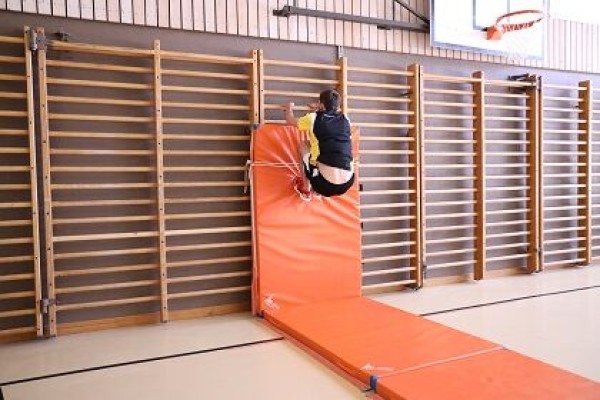
A straight run-up to the wall bars, frontal jump from a freely selectable distance, to cushion the impact, the feet first hit the soft mat attached to the wall, then immediately hold on to the wall bars with the hands.
outdoor I:
The participant takes a running start and jumps off in front of the wall, holds on to the wall and tries to overcome it.
Simplify: Just hold on to the wall and then let go again and land safely.
outdoor II:
The participant takes a running start, jumps off and holds on to the wall. The participant then tries to move along the wall in the hanging position. The knees are in front of the chest and the arms are outstretched. In order to move sideways, the front hand and the front leg must be moved simultaneously in the direction of movement.
1 wall bars ►indoor version
2 soft mats (small) ►indoor version
2 skipping ropes ►indoor version
Indoor post set-up:
Tie a set-up soft mat to the wall bars with skipping ropes, place a second soft mat on the floor in front of it.
Jump to the slope II
Parkour
Individual work
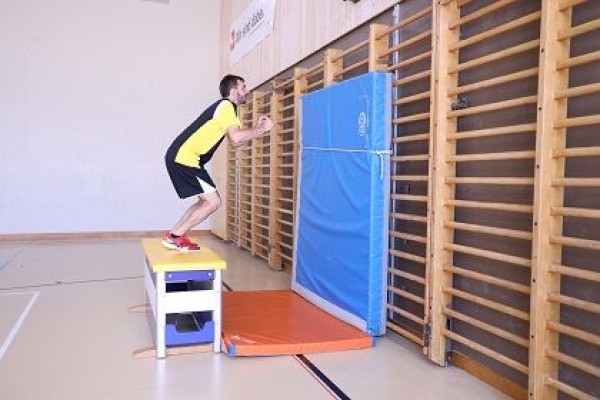
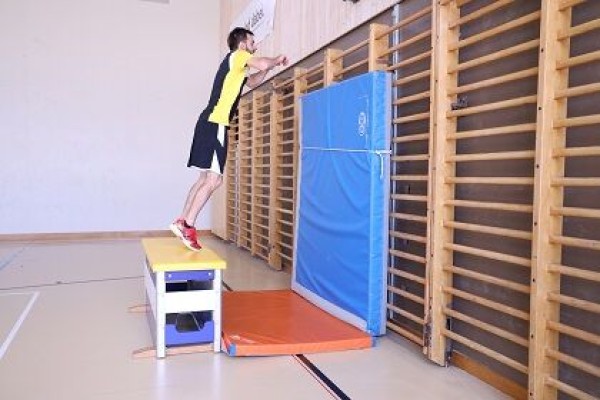
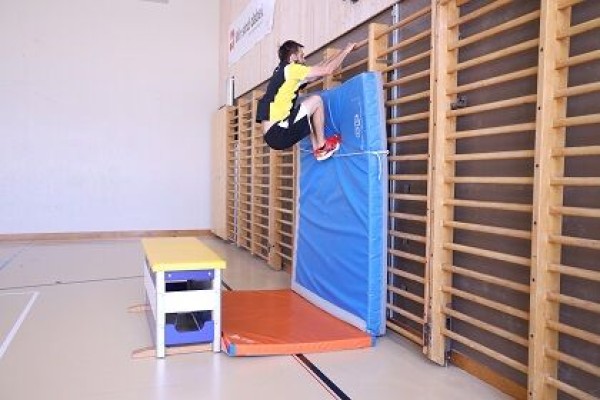
Both-legged jump from a standing position from the vaulting box, to cushion the impact first hit your feet on the soft mat attached to the wall, then immediately hold on to the wall bars with your hands.
Variant:
Execute the exercise from the movement with a straight run-up and frontal one-legged jump from the vaulting box.
1 wall bars
1 vaulting box
1 soft mat (medium-sized)
1 soft mat (small)
2 skipping ropes
Post set-up:
Tie a medium-sized soft mat with skipping ropes to the wall bars, place a small soft mat in front of the wall bars and a vaulting box (2-3 elements) behind it
Jump to the slope III
Parkour
Individual work
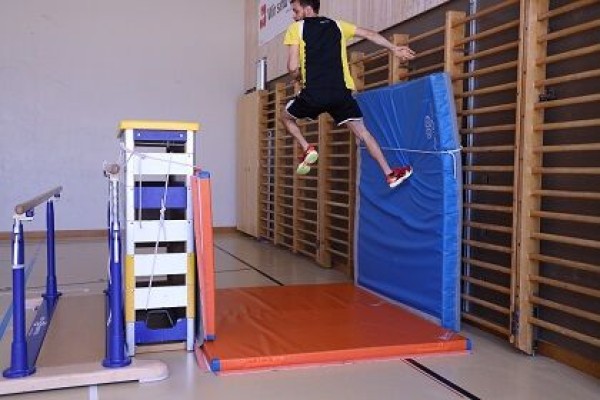

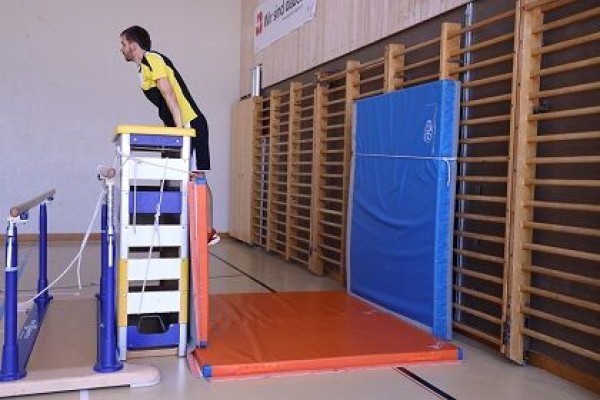
Hang on the wall bars with your back to the vaulting box, jump with a 180 degree turn to the slope on the vaulting box. To cushion the impact, first hit your feet on the soft mat, then support yourself with your hands on the vaulting box and climb up onto it.
1 wall bars
1 vaulting box
1 parallel bars
1 soft mat (medium)
1 soft mat (small)
6 skipping ropes
Post set-up:
Tie a set-up medium soft mat to the wall bars with skipping ropes, place a vaulting box (6-7 elements incl. top) approx. 150cm away and attach (e.g. using skipping ropes to a parallel bar). 150cm away, place a vaulting box (6-7 elements incl. top section) and attach it (e.g. to a parallel bar using skipping ropes), attach a small soft mat to the front of the vaulting box using skipping ropes.